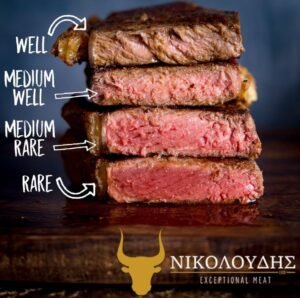One of the questions I get asked often is how to cook the perfect steak. Obviously, how you like your steak cooked is a matter of personal preference. I like my steak medium-rare, and I’d rather it be on the rare side than medium. Regardless of temperature, to me, the perfect steak should have a nice crust on the outside that you get from grilling. And it needs to cook evenly all the way through—without graduating shades of brown until you get to the pink center.
There is a logical reason for each of the steps involved in cooking the perfect steak. Grilling meat first initiates the Maillard reaction, a chemical reaction that occurs as a result of high heat in which the amino acids and sugar present in the meat’s fibers recombine, resulting in the brown color and increased flavor. Grilling also helps the seasonings adhere to the steak. Allowing the steak to rest after grilling helps to even out the temperature throughout the steak. It also gives the temperature in the center a chance to rise above room temperature. Cooking the steak in an oven at 230°C continues to brown the steak, which adds more flavor. And by cooking the steak at the lowest oven temperature, 150°C, a small miracle happens: at the edge of the steak, the temperature stops somewhere between 60 and 72°C, while the temperature in the center rises, so that the steak is cooked evenly. The degree to which the temperature rises once the steak comes out of the oven is more predictable. When a steak comes out of the oven at 230°C, the temperature rises very quickly, which makes you more prone to overcooking the steak. The final resting period fully equalizes the internal temperature of the steak, so it does not continue to cook once served. When choosing the desired temperature at which to cook your steak, note that the internal temperature will rise by 2 to 4°C after you remove it from the oven. When making steaks, I find that I get the best results if I use a sea salt (my preference is Maldon sea salt) and a medium-coarse pepper. I like a mix of red, white and black peppercorns, but black pepper would work just fine too. You will need a meat thermometer to achieve a perfect steak and preferably an infrared thermometer. With this you can check the readiness of the meat as well as the readiness of the pan in which you cook it.
BONE OR NO BONE
Many chefs like to say that cooking meat on the bone makes the meat taste better. If you want to gnaw on the intercostal meat you’ll find on the bone in the ribs, and no one is a bigger fan of that than I am, then that’s the biggest advantage of the bone. Cooking a steak bone-in also helps the steak hold its shape and can even prevent the steak from overcooking, since the bone, which remains cold, protects one side of the steak. But does it add flavor? Do you think the flavor escapes from the bone into the meat? No way. Impossible!





